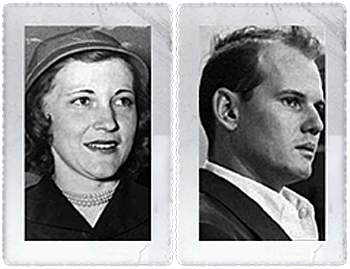

A decade before the fictitious story of Richard Kimble was first told, a very similar tale — also involving a respected doctor, his murdered wife, and a mysterious alleged intruder in their Midwestern home — occupied the attention of the American public; but this case, the 1954 murder trial of Dr. Sam Sheppard, was not fiction.
Sheppard, a Cleveland osteopath, was convicted of second-degree murder after his pregnant wife Marilyn was found bludgeoned to death at the couple's suburban Bay Village home. He claimed the real killer was a large, bushy-haired man who broke into the house, possibly hoping to steal some morphine from the medical supplies he kept there. Sheppard testified that he fought with the intruder, who however knocked him unconscious. Police were unable to locate this individual, and instead Sheppard was held to be the guilty party, though there was never any hard forensic evidence against him. Luckily, however, Sheppard was not sentenced to death, since his conviction was later overturned in a new trial — which, perhaps not coincidentally, took place during the years when The Fugitive first aired. He had served 10 years of his life sentence when a judge freed him in 1964, ruling excessive media coverage tainted the original trial. A second jury acquitted him in a new trial in 1966.
The TV show deviated in some details from the Sheppard story. For instance, Kimble's wife was definitely not pregnant at the time of her death; in fact the argument she was having with him that fateful night involved the couple's infertility and whether or not they should resort to adoption. The Sheppards though were quite the fertile couple, and had, in addition to the unborn child, a seven-year-old son, Chip, who apparently slept right through the murder.
But many other facets of the Sheppard story found their way intact into various episodes of the later TV show. For instance, Sheppard's parents both died soon after his conviction, much like Kimble's do. And at his trial, prosecutors besmirched Sheppard's reputation by showing that he had kissed some of his female patients. Kimble of course also has more than his share of female trouble over the years.
While Sheppard went to an early grave in 1970 at the age of 46, his grown-up son recently sued the state of Ohio, asking the state to declare his father innocent and pay compensation of at least $250,000 for the decade his father spent in prison. To prove his father's innocence beyond all doubt, the son searched for DNA evidence — an idea that the writers of The Fugitive would surely not have overlooked if technology had been advanced enough back in the '60s. An expert from Indianapolis claimed that DNA tests of blood saved from the crime scene back up Sheppard's story. The tests reveal that the blood was not Mrs. Sheppard's, and it was shown at the time of the killing that Dr. Sheppard had no wounds that bled. Hence, a third person had to have been on the scene — possibly the Sheppards' window-washer, who is serving a life sentence for killing another woman?
Unfortunately, the jury decided that the DNA evidence was not compelling enough to support the claims of Sheppard's son. However, the same jury also detected enough DNA from Sheppard's story in the episode THE GIRL FROM LITTLE EGYPT to definitively conclude that Fugitive creator Roy Huggins was influenced by the case, despite his vehement and repeated assertions to the contrary.
Sheppard's story served as the basis for a 1975 TV docudrama, Guilty or Innocent: The Sam Sheppard Murder Case — a movie which co-starred William Windom, who played a fateful role in The Fugitive as well.
(Compiled from Reuters and The New York Times. See also: Human Rights Vol. 24, No. 3 and http://www.pbs.org/nova/sheppard)
 Back to HOMEPAGE OF THE HUNTED <http://unchance.net/Fugitive>
Back to HOMEPAGE OF THE HUNTED <http://unchance.net/Fugitive>